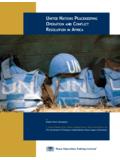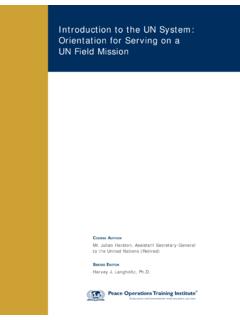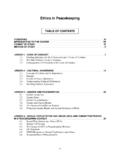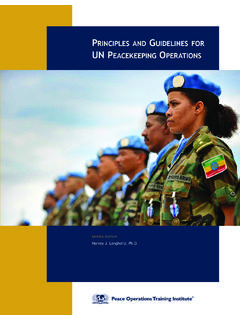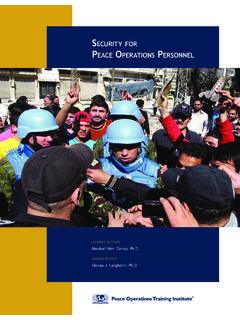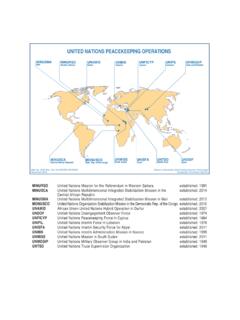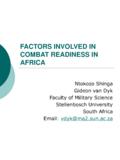Transcription of Disarmament, Demobilization, and Reintegration …
1 Peace Operations Training Institute Study peace and humanitarian relief any place, any timeCourse AuthorMr. Cornelis Steenken DDR/SALW/SSR/Post-conflict consultantSeries EditorHarvey J. Langholtz, , demobilization , and Reintegration (DDR): A Practical OverviewPeace Operations Training Institute Study peace and humanitarian relief any place, any timeCourse AuthorMr. Cornelis Steenken DDR/SALW/SSR/Post-conflict consultantSeries EditorHarvey J. Langholtz, , demobilization , and Reintegration (DDR): A Practical OverviewCover Photo: UN Photo #535676 by Basile Zoma.
2 An officer of the disarmament , demobilization , and Reintegration programme (DDR) of the UN Operation in C te d Ivoire (UNOCI) supervises the collection of weapons by UN peacekeepers and the Republican Forces of C te d Ivoire (FRCI). 1 February 2012. 2017 Peace Operations Training Institute. All rights Operations Training Institute 1309 Jamestown Road, Suite 202 Williamsburg, VA 23185 USA edition: 2008 by Yvan Conoir The material contained herein does not necessarily reflect the views of the Peace Operations Training Institute (POTI), the Course Author(s), or any United Nations organs or affiliated organizations.
3 The Peace Operations Training Institute is an international not-for-profit NGO registered as a 501(c)(3) with the Internal Revenue Service of the United States of America. The Peace Operations Training Institute is a separate legal entity from the United Nations. Although every effort has been made to verify the contents of this course, the Peace Operations Training Institute and the Course Author(s) disclaim any and all responsibility for facts and opinions contained in the text, which have been assimilated largely from open media and other independent sources. This course was written to be a pedagogical and teaching document, consistent with existing UN policy and doctrine, but this course does not establish or promulgate doctrine.
4 Only officially vetted and approved UN documents may establish or promulgate UN policy or doctrine. Information with diametrically opposing views is sometimes provided on given topics, in order to stimulate scholarly interest, and is in keeping with the norms of pure and free academic pursuit. Versions of this course offered in other languages may differ slightly from the primary English master copy. Translators make every effort to retain the integrity of the OPERATiONS TRAiNiNG iNSTiTUTET able of ContentsDisarmament, demobilization , and Reintegration (DDR): A Practical OverviewForeword xMethod of Study xiiiLesson 1 Outline and Context of DDR 14 Section Introduction 16 Section Context of DDR 17 Section DDR Terminology 17 Section Objectives of DDR 21 Section Post-Conflict Environment 21 Section Post-Conflict Security Situation 23 Section Security Concerns of Demobilized Combatants 24 Section What is a DDRP?
5 24 Section Security Threat Posed by XCs 30 Section Impact of Past Programmes 30 Section Conclusion 31 Lesson 2 Participants, Beneficiaries, and Actors in DDRPs 34 Section Participants and Beneficiaries 36 disarmament , demobilization , AnD Reintegration (DDR): A PRACTICAL OvERvIEWPEACE OPERATIONS TRAINING INSTITUTEviSection Communities 37 Section XCs as a Specific needs group 37 Section Targeted Assistance 39 Section Eligibility and Screening Mechanisms 41 Section Specific needs of Female XCs, veterans Wives, and War Widows 44 Section Youth 52 Section Children Associated with Armed Forces or Armed groups 54 Section Disabled XCs 64 Lesson 3 disarmament and Small Arms Control 74 Section Basic Principles of disarmament 77 Section The Four Main Phases of disarmament 79 Section SALW Weapon Control and disarmament 85 Lesson 4 demobilization 90 Section Approaches to demobilization 92 Section Planning and Preparation 93 Section Conduct of demobilization 96 Section Camp Support and Internal Programming 100 Section Information Campaigns to Help
6 Expectations Management and Support to demobilization 103 Section The Moment of demobilization (Discharge) 104 Section Reinsertion 105 Section Conclusions 107 disarmament , demobilization , AnD Reintegration (DDR): A PRACTICAL OvERvIEWPEACE OPERATIONS TRAINING INSTITUTEviiLesson 5 Reintegration 110 Section Introduction 111 Section Security needs for Reintegration 113 Section Economic Reintegration 115 Section Social Reintegration 121 Section Political Reintegration 127 Section Reintegration Planning and Design 131 Section Reintegration needs Assessment 136 Section Reintegration Programme Funding Issues 139 Section Conclusion 142 Lesson 6 Post-Conflict Issues and Linkages to DDR 146 Section The Post-Conflict Security Situation 149 Section DDR and SSR
7 151 Section Un Military Roles and Responsibilities in DDR 155 Section Un Police Roles and Responsibilities in DDR 157 Section DDR and TJ 159 Section natural Resources and DDR 165 Section Summary of DDR Linkages to other Humanitarian and Peacebuilding Programmes 166 Lesson 7 DDR Challenges and Current Issues 170 Section DDR History and Policy 172 Section DDR Programming Challenges 174 Section Community violence Reduction and Haiti 177 Section DDR and Countering violent Extremism or demobilization and Disengagement of violent Extremists 179 disarmament , demobilization , AnD Reintegration (DDR): A PRACTICAL OvERvIEWPEACE OPERATIONS TRAINING INSTITUTE viiiSection DDR Measures of Success the Quantification of DDR 182 Section DDR and Corruption 184 Section Private Military and Security Companies versus Mercenaries and DDR 186 disarmament , demobilization , AnD Reintegration (DDR): A PRACTICAL OvERvIEWPEACE OPERATIONS TRAINING INSTITUTEIXA ppendicesAppendix A: List of Acronyms 192 Appendix B: glossary of DDR Terms and Principles 196 Appendix C: IDDRS glossary of Terms and Definitions 231 Appendix D.
8 Current Peacekeeping Missions 235 About the Author: Mr. Cornelis Steenken 236 Instructions for the End-of-Course Examination 237 disarmament , demobilization , AnD Reintegration (DDR): A PRACTICAL OvERvIEWPEACE OPERATIONS TRAINING INSTITUTEXThe end of the Cold War was a contributing factor to the end of many intra-State conflicts in Latin American and African countries. These countries used the fledgling concept of disarmament , demobilization , and Reintegration (DDR) to disband former warring factions, downsize their national armed forces, and provide both sides with short- to medium-term alternate civilian employment.
9 Unfortunately, the end of the Cold War also contributed greatly to the supply of cheap, easy-to-use weapons and ammunition, which encouraged or facilitated other conflicts. Some of these conflicts have continued for multiple years even decades and are now seeking resolution of a broad range of contextually different civil conflicts by further application of the concept of DDR to disband and disarm guerrillas, irregular armies, and armed groups, and to sustainably reintegrate former combatants. In the transition period following a civil conflict, there are a host of actors involved in the overall transition from war to peace in a country.
10 These include the former warring factions, different local and national government actors and ministries, and regional power players as well as a host of external actors; factions (such as former colonial powers); regional power blocs; and international actors like the United nations, donors, and non-governmental DDR programme is but one of the many programmes that run concurrently at the outset of a peace process. All of them need to be resourced; proper phasing and prioritization is key. DDR programmes are multidimensional and include a host of social, economic, political, military, and/or fiscal objectives that are part of the overall peace and recovery strategy.
